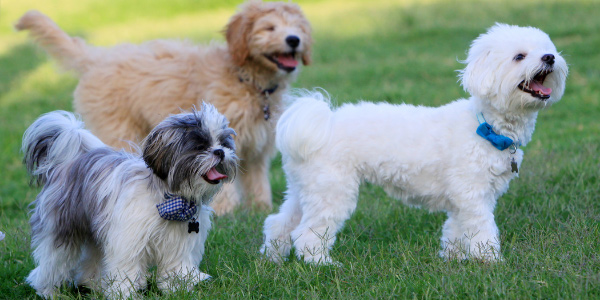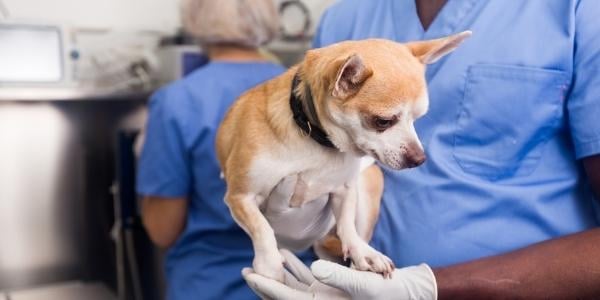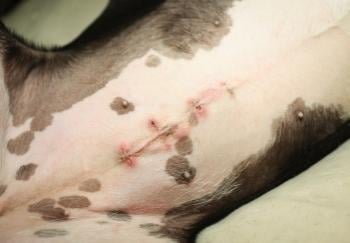 Life is truly a balancing act. We often have to make choices that make us feel as if we are darned if we do and darned if we don’t.
Life is truly a balancing act. We often have to make choices that make us feel as if we are darned if we do and darned if we don’t.
I think that is often how dog owners (and veterinarians) feel when trying to decide on the right time to spay and neuter their pets. Additionally, many people are unsure as to whether or not they even want to spay or neuter their dog at all.
When you spay or neuter your dog is a personal decision based on many factors.
Making the choice of doing it early or waiting until your dog is older is truly a very personal decision dependent on many factors. The purpose of this article is to give you, as a dog owner, the information you need to make an informed decision. In no way is it intended to persuade you on when to spay or neuter your pet. But, as I'll dive into further below, it is important to spay or neuter your pet at some point in their life rather than not at all.
Considerations for Spay/Neuter Timing
Vet Recommendations on Timing
Challenges of Living with an Intact Dog
Why You Should Spay/Neuter Your Dog
Pros and Cons of Spay or Neuter
How Much Does Spay or Neuter Cost?
“AVMA promotes the professional judgement of the veterinarian in developing an informed, case-by-case assessment of each individual patient, taking into account all the potential risks and benefits of spay/neuter.”
— Dr. Kendall Houlihan, an American Veterinary Medical Association assistant director of animal welfare
Considerations When Deciding When to Spay or Neuter Your Dog
There are many things to consider when you are deciding on the right time to spay or neuter your dog. There isn't a "one-size-fits-all" approach that can be used. Here are just some basic things to think about when deciding on your dog's spay or neuter timing:
- Size of your dog. Preliminary research studies regarding certain health issues indicate that large breed dogs should have a delayed spay or neuter.
- Age of your dog. Spay and neuter costs are higher for older dogs and they typically have a slower recovery than younger dogs.
- Sex of your dog. Delaying a spay increases the chances of mammary tumors and there is a risk of pregnancy. Delaying neutering can increase roaming and potential behavioral issues. Additionally, with each heat your female dog is at risk of developing pyometra (a dangerous infection of the uterus).
- Breed and temperament. Studies indicate that large breed dogs should have a delayed spay or neuter procedure.

- Behavioral issues. Dogs who exhibit true aggressive behavior should be spayed and neutered. However, the procedure isn't a quick fix for many behavioral issues, and in some cases can exacerbate them, as I'll discuss further below.
- Your dog's intended use. Working dog, show dog, part of a reputable breeding program, etc. Dogs intended for specific purposes are often left intact until later in life.
- Health of your dog. Dogs born with congenital issues should be spayed or neutered, which is normally recommended sooner rather than later.
- Your dog's weight. When your dog gets larger, it requires more anesthetic drugs and increased dosages of pain medications. Both of which add more cost to the spay or neuter procedure. Additionally, when female dogs are overweight, more fat often accumulates around the ovaries. This can increase the risk of complications, as well as increase the cost because the procedure is more complex and more surgical supplies are needed.
Smaller and leaner dogs cost less to spay or neuter and typically recover better than larger or overweight dogs. While having an overweight or obese do is not a reason to NOT fix your dog, it's important to know about how this affects their procedure. - Your location and local dog culture. Some areas have a lot of stray dogs, making having an intact dog more challenging and increasing the risk of pregnancy.
- Where you got your dog. Rescues and shelters require all dogs be spayed or neutered within a specific time frame (if not already done prior to adoption). Breeders also may require spay or neuter at a certain point in a dog's life, often recommended around the age of adult maturity. There are often contractual agreements regarding spay or neuter and that dogs cannot be bred without their knowledge or outside of their breeding program.
- Your lifestyle. It's important to determine if your lifestyle allows you to be a responsible owner of an intact dog without causing you extra stress. For example, controlling an intact male when he can smell females in heat three miles away can be difficult. Females in heat can attract unwanted visitors and there is the "mess" to contend with during heat cycles.
- The financial cost and increased health risks to your dog. Delayed spays or neuters can come with associated financial and health issues. Older and larger pets often cost more to spay or neuter, and potential health issues can complicate the procedure which increases fees.

Veterinary Recommendations for When to Spay or Neuter Your Dog
Prior to recent studies (which predominately relate to large breed dogs), all pets were recommended to be spayed or neutered between 6 and 8 months, unless they were going to be used for breeding. But with recent studies linking early spay and neuter to certain health issues – which was only evaluated in large breed dogs — it is necessary to rethink the best time to have these procedures done.
Research into spay and neuter timing has raised concerns primarily in regards to:
- Orthopedic issues, such as hip dysplasia, elbow dysplasia, and cranial cruciate ligament (CCL) tears
- Cancer
- Urinary incontinence
- Immune-mediated disorders, such as atopic dermatitis, autoimmune hemolytic anemia, diabetes mellitus, hypoadrenocorticism (Addison's disease), hypothyroidism, immune-mediated thrombocytopenia, inflammatory bowel disease (IBS), systemic lupus erythematosus
With that said, the research predominately focuses on large purebred dogs, such as Golden Retrievers, Labrador Retrievers, and German Shepherds, and the issues early spaying/neutering may have on them. But it also stimulated a review of standards with regards to cats as well as small and medium-sized dogs. There are other studies involving smaller breeds, but those studies have all been small. It is universally agreed upon that more research needs to be done, especially as research continues to demonstrate the broadening impact that early spay and neuter is having on our pets' health and longevity.
Delayed spaying and neutering in large or giant breed dogs does not guarantee they will not have orthopedic issues or cancer.1
When we think of dogs, whether it relates to food, toys, and even surgery (the amount of anesthesia and pain medication needed, for example), we tend to classify them as small, medium, large, or giant breeds. These classifications impact owners and veterinarians when making decisions about spaying and neutering due to recent research from UC Davis indicating potential benefits of delaying the procedure based on the size of the dog.
To give you a general range of spay/neuter timing typically recommended by veterinarians, I've included the sections below. The following standards, for each size of a dog, follow the American Animal Hospital Association Canine Life Stage Guidelines.
When to Spay or Neuter a Small Breed Dog
A dog is considered a small breed dog if their ideal adult weight is less than 22 pounds.
Since small breed dogs do not have the same orthopedic issues as large breed dogs, it is recommended that females be spayed before their first heat (around 5 to 6 months) and males be neutered at 6 months of age.
 When to Spay or Neuter a Medium Breed Dog
When to Spay or Neuter a Medium Breed Dog
A dog is considered a medium breed dog if their ideal adult weight is between 25 and 45 pounds.
Dogs that fall in this weight range should be spayed before their first heat (5 to 6 months) and neutered by 6 months of age.
When to Spay or Neuter Large a Giant Breed Dog
A dog is considered a large breed dog if their ideal adult weight is over 45 pounds. Giant breeds are dogs weighing 75 pounds or more.
Any dog that will be over 45 pounds as an adult should be neutered after their growth stops. This time period is typically between 9 and 15 months of age.
For females, the decision to spay is based on additional factors. Some of these factors include your dog’s disease risk as well as your and your dog's lifestyle. After reviewing the pros and cons with your veterinarian, together, you may alter the recommended window to between 5 and 15 months.
What if Your Dog's Breeder Requests You to Wait Longer to Spay or Neuter?
Often breeders or breed groups will recommend waiting to spay or neuter a dog up until 2 years of age.
Why is there a disconnect between veterinary standards and breeder recommendations? The OFA certification (an evaluation of a dog's hips done by the Orthopedic Foundation for Animals) cannot be done until a dog is 2 years old. This evaluation is integral to reputable breeding programs to limit the occurrence of hip dysplasia and other orthopedic issues in future generations. Therefore, dogs who may potentially contribute to their breeding lines are asked to wait longer until the OFA and other health tests have been completed and their breeding program status determined.
In other cases, breeders may recommend waiting to spay or neuter later so the dog can benefit from the prolonged exposure to hormones, even if that dog will not be bred.
 Challenges of Living with an Intact Dog
Challenges of Living with an Intact Dog
Having an intact dog means you'll need to be more aware of potential behavior challenges, medical issues, and difficulty in finding certain services for your dog.
- You'll need to be more diligent in preventing the roaming of intact males.
- You'll need to protect intact females when in heat since they may roam and males can smell them up to three miles away.
- With each heat, females are at risk of developing uterine infections (pyometra) or getting pregnant. Therefore, owners need to take special precautions and monitor them closely.
- Many dog daycares and some boarding facilities do not allow intact dogs after a certain age. Make sure you have a trustworthy pet sitter or other arrangements for when you need to take a trip without your dog. One option is to contact the breeder of your dog and ask if they are able to petsit your dog when needed.
- Female dogs in heat go through behavioral changes, stress, pseudo-pregnancy, and need some management of the "mess" involved. Learn more and get tips in "Delaying a Spay: Dog Behavior While 'In Heat'."
Why You Should Spay or Neuter Your Dog
Now that we've discussed the recommendations for the WHEN to spay or neuter your dog, I do want to touch on why it's important to spay or neuter your dog in the first place. It is important to balance not only the benefits to society but also the medical and behavioral benefits to pets and their owners.
It is asserted, by the American College of Theriogenologists and the Society of Theriogenology, that any companion animal that is not intended for breeding should be spayed or neutered. They also state that any potential consequences for each animal must be considered with the management of the animal and the overall breed population.
It's not a question of IF to spay or neuter your dog, but WHEN. Discuss with your veterinarian about the best timing for your dog's spay or neuter procedure, making sure to talk about the considerations for spay/neuter timing I mentioned earlier.
From a behavioral standpoint, aggressive dogs should always be spayed or neutered. This is not because spaying or neutering will necessarily diminish aggressive behavior (studies are still looking into whether it has a consistent and positive impact on aggression), but because we do not want any aggressive genetic traits to be passed down to future generations of dogs.
Benefits and Risks of Canine Spaying and Neutering
Personally, I am one of those people who can’t make a decision without looking at the pros and cons. Then even after I make a list, I re-evaluate the list again to see if the pros are really pros and the cons are really cons, based on my situation and circumstances. Hopefully, with the help of your veterinarian, your decision-making process for spaying and neutering will be much simpler.
I want to provide you with a list of general benefits and risks that will help (I hope) you make the best choice for yourself and your pet. Remember, this decision is based entirely on what works best for you, your pet, and the lifestyle you both live.
I think it is important to point out that animals do not think the same way we do.
Male pets do not feel less masculine when neutered, and female dogs will not miss the joy of motherhood.
Health Benefits of Spaying Your Dog
- Eliminates the risk of pregnancy and helps control the pet population.
- Eliminates heat cycles in female dogs. In doing so, it helps eliminate erratic behavior and bloody vaginal discharge.
- Eliminates certain medical issues, such as cancer with the ovaries and uterus.
- Drastically decreases the risk of mammary cancer. 1 in 4 unspayed female dogs will develop mammary cancer. Mammary cancer is malignant in around 50% of dogs diagnosed, and survival is usually less than a year.2
- A routine spay is more cost-effective than having emergency surgery for a uterine emergency (pyometra) or dystocia (difficult birth), which may require a C-section. Both of these procedures can cost thousands of dollars and can be life-threatening.
- Typically, spayed dogs have a longer life expectancy.3
Health Benefits of Neutering Your Dog
- Eliminates the risk of testicular cancer.
- Reduces the risk of prostatic disease.4 All intact male dogs will experience benign prostatic hyperplasia and hypertrophy (prostate gland enlargement), usually around 6 years old. Although these dogs will be predisposed to prostatic infections, only a small subset will develop infections or show clinical signs of discomfort.
- Helps reduce the risk of perineal hernias and perianal tumors.
- Typically neutered dogs have a longer life expectancy.3
Behavioral Benefits of Spaying or Neutering Your Dog
- Neutered males often have a decreased desire to roam. Neutering helps decrease the risk, when roaming, of being shot, hit by a car, or getting into fights with other dogs. Males can smell an in-heat female up to three miles away. An intact male's strong instinctual desire to find them often overrides their training.
- Neutering and spaying can help reduce indoor urine marking
- Neutering can help reduce unwanted sexual behaviors, such as mounting and masturbation
- In one study, neutering of male dogs also showed a decrease in vocalization due to separation anxiety and distress
Behavioral Risks of Spaying or Neutering
When dealing with problematic behavioral issues, in the past many dog trainers and behavior consultants had recommended spaying or neutering as a first course of action. However, with increasing studies being done on the impact of this procedure on certain behavioral traits, this standard is changing.
Some study results have noted an increase in possessive aggression (resource guarding), fear-related behaviors, and over-excitability in male dogs after neutering, more so when they are neutered earlier rather than later. Spaying may also cause an increase in owner-directed aggression, resource guarding, and fearful reactivity in female dogs, also linked to the timing of the spay.5
The question for professional canine behavior consultants then comes down to not if someone should spay or neuter their dog, but when. More studies are needed to help us better understand the behavioral consequences of early spaying and neutering. But the trend does point towards the benefits of allowing our dogs to remain intact longer to allow for more hormonal exposure and growth.
Risks of Spaying or Neutering
- Following spaying or neutering, some pets gain weight. This happens because of the loss in some hormones, such as estradiol and testosterone, as well as a shift in other hormones, like leptin and insulin. This combination results in a lower metabolism but an increase in appetite. Additionally, there can be a redistribution of fat, especially around the abdominal area, which makes a dog look fatter. Weight gain can be controlled by measuring your pet’s food intake and increasing their exercise.
- Financial constraints. Although routine procedures are significantly more cost-effective than emergency procedures, the cost of spaying and neutering can prevent some people from doing it. There are options like low-cost spay/neuter clinics and some pet insurance policies include coverage for this procedure as part of their wellness plans. The size of your dog, as well as where you live, impacts the cost of spaying and neutering.
- Risks of anesthesia. Anesthesia for pets is as safe as it is for humans. However, risks of anesthesia increase when procedures are done for emergency purposes such as during a pyometra, dystocia (difficult birth), or testicular torsion.
- Increased risk of urinary incontinence in female dogs.
- Increased risk of immune-mediated disorders.
- Certain dog breeds are known for inherited health conditions. Studies indicate that, for some inherited conditions, neutering can increase the risk of expression.

- Surgery on any overweight animal increases risks during anesthesia. Spaying an overweight dog has additional risks due to the vessels being surrounded by a heavy layer of fat, making it complicated to tie off these blood vessels. The greasy nature of the fat can also cause the suture to slip more easily. Overweight dogs often require larger incisions, which are more likely to open up and have a higher likelihood of infection. Overweight dogs also may take longer to recover from anesthesia because the fat absorbs and stores the anesthetic drugs. If your dog is overweight, learn how to help them lose weight here.
How Much Does a Dog Spay or Neuter Cost?
Average Cost for Spaying or Neutering a Dog
The average price of a spay or neuter procedure depends a lot on where you are located and the presence of low-cost clinics.
- The cost of a routine neuter can range from around $200 to $700. Some locations may charge more, and low-cost clinics may charge less. According to Marketwatch, the average cost of a dog neuter in 2025 is $435.
- The cost of a routine spay can range between $200 and $700. Some locations may charge more, and low-cost clinics may charge less.
Factors that Affect Cost of a Spay or Neuter
When it comes to the cost of spaying and neutering dogs, there are several factors that impact the cost.
- Age. Younger pets are generally easier to perform the procedures on than older pets since they are healthier and smaller (smaller vessels, less fat, fewer sutures, etc).
- Size. Larger pets require more anesthetic drugs, the surgical site takes longer to clip and prep, the surgery generally takes longer, more surgical supplies are needed, and generally, more pain medication is required.
- Breed. Brachycephalic dogs, like Pugs and Bulldogs, require more surgical time and are higher-risk patients due to their breathing issues.
- Weight. Overweight animals require more surgical time and supplies, including anesthesia.
- In Heat or Pregnant. Pets that are in heat or pregnant require longer surgical times due to the increase in blood vessels that are feeding into the ovaries and uterus. Some owners need their female dog spayed while she is in heat due to increased risk of pregnancy, while pregnant dogs may require an emergency c-section and then spay procedure in order to save the dog's life and hopefully her puppies as well.
- Health status. When these procedures must be done on sick pets, the cost goes up drastically due to the additional treatments, such as intravenous fluids, pain medications, antibiotics, and hospitalization. There is also an increased risk of complications when pets are sick.
- Your location. The cost of care varies from region to region. Leasing and real estate costs, cost for veterinary salaries, support staff, and specialized equipment are all based on location. So, this impacts the cost of veterinary services.

Should You Have Your Dog Spayed or Neutered at a Low-Cost Clinic?
Low-cost spay and neuter clinics typically charge much less than general practice veterinary clinics. This is due to the fact that they can obtain grants and have volunteer help.
Additionally, many of these clinics do not perform pre-surgical exams, bloodwork, place catheters, run IV fluids, etc., which helps in keeping their costs lower. General practice veterinary clinics are using the highest quality medications, equipment, and highly trained staff, which costs more.
Since low-cost clinics typically aren't able to monitor your dog’s temperature, oxygen level, blood pressure, heart rhythm, carbon dioxide level, and pulse rate, this increases the risks of complications. Fluids are essential to maintain hydration during surgery as well as manage your dog’s blood pressure. Additionally, in emergency situations, the lack of fluids and a catheter can potentially increase the chances of death since the veins often collapse which makes administering emergency drugs difficult.
Many low-cost clinics are not held to the same standards for surgical room protocol and instrument sterilization. This increases the risk of infection. Infections in the surgical site can risk the area opening up which will require surgery as well as intensive antibiotic treatments.
Normally dogs are discharged from the facility at closing. If your dog has any complications it will require a visit to an emergency clinic which can be costly. Typically, a general practice veterinary clinic will hospitalize your pet overnight or they are available for emergency calls. If they do not perform the procedure, they cannot advise you on what to do without extensive evaluation, which can be expensive.
When deciding where to have your dog's spay or neuter procedure done, do your research and ask the clinic lots of questions about pre-op testing, procedural protocols, and post-op support. Low-cost spay and neuter clinics have played an integral role in helping control pet overpopulation and providing this essential service to those who may not be able to afford it otherwise. However, it's important that you feel comfortable with how your dog's surgery will be done and what support you will have should complications arise.
As I have said repeatedly, the decision to spay and neuter your dog is dependent on a variety of factors. I recommend you discuss these things with your veterinarian and make the choice that suits you and your dog.



